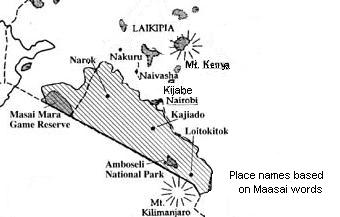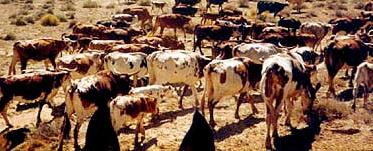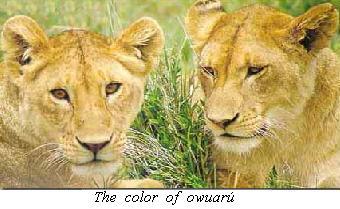 common
words and phrases in the Maa language. For a small sampling, the
following fairly well-known place names come from the indicated Maasai
words; some of these could be found in a good English dictionary.
common
words and phrases in the Maa language. For a small sampling, the
following fairly well-known place names come from the indicated Maasai
words; some of these could be found in a good English dictionary.
Just as individuals change throughout their lifetime, so any normal language changes throughout its lifetime. Speakers encounter new things they want to talk about, and may do business and inter-marry with members of other language communities. In the process, they often need to develop new vocabulary and routinely creatively develop new meanings for old words. Some major types of change are: BORROWING words from one language to another, gradually developing NEW MEANINGS FOR OLD WORDS (and sometimes new grammar along the way), COINING new words, and losing old words.
Borrowing from Maa into other languages
The Maa language has been a source from which other
languages have borrowed. Many place names in modern-day Kenya and
Tanzania correspond to  common
words and phrases in the Maa language. For a small sampling, the
following fairly well-known place names come from the indicated Maasai
words; some of these could be found in a good English dictionary.
common
words and phrases in the Maa language. For a small sampling, the
following fairly well-known place names come from the indicated Maasai
words; some of these could be found in a good English dictionary.
| Nairobi | is
from |
na- |
'that (place) which is cold'
The capital of Kenya, located in the generally cool Kenyan highlands |
| Kijabi | en-kijáp |
'wind'
Location of a famous boarding school on the windy eastern edge of the Great Rift Valley (the cornerstone of this school was laid by Teddy Roosevelt) |
|
| Amboseli | em-pósél | 'salty dust'
A game park reserve in Southern Kenya, noted for its wildlife |
|
| Kajiado | 'the huge leg (river) which
is long'
A major business and market center, south of Nairobi |
||
| Naivasha | 'that which is churning/heaving'
A lake well-known for its wild-life, including pink flamingos |
||
| Nakuru | na-kírr-ò | 'that which is scratched
off bare'
A major city north of Nairobi |
|
| Narok | enk-ár |
'the water that is black'
A major town on the western edge of the Great Rift Valley |
From even these few examples, it is clear that Maa words have become the nationally and internationally-acknowledged names for certain cities and land features in East Africa. This is important historical-linguistic evidence for what language groups likely inhabited or frequented these geographic places when the colonial map-makers first visited East Africa. By similarly examining the vocabularies of multiple languages, one can begin to deduce pieces of the histories of those who speak the languages. Detailed study of the Maa language will contribute to understanding the chronological, cosmological, and economic history of the Maa peoples; as well as understanding contact between Maasai and other ethnic groups, and ultimately to the history of the entire East African region.
Borrowing into Maasai
As with many ethnic groups around the world, the Maa peoples have had a long history of contact with other language groups, with resultant borrowing of words between languages. Borrowing is a natural process, and is not a degradation of a language. Instead, borrowings may give some witness to the economic, cultural and political interchanges that speakers of the language have had with other language groups.
To illustrate, em-búku 'book' is obviously borrowed from English. The word is now fully integrated into Maa, as seen by how it follows the rules of Maa phonology and morphology (cf. plural im-búkúí). This borrowing is of interest, given that many other languages of East Africa have borrowed an Arabic word to denote the concept 'book,' namely a word with the consonants k-t-b. The fact that Maa has borrowed an Engish word for this concept, and not an Arabic one (nor even a Swahili one -- which itself borrowed the k-t-b word from Arabic) is an interesting detail from which one can begin to trace the types of inter-cultural situations obtaining at the point in history when Maa speakers first wanted to refer to 'books.'
Ol-d![]() ka'shop'
(plural il-d
ka'shop'
(plural il-d![]() ka
ka![]() ),
by contrast, is surely borrowed from Swahili, reflecting a different sphere
of socio-economic and cultural interchange with Bantu or Arabic speaking
peoples.
),
by contrast, is surely borrowed from Swahili, reflecting a different sphere
of socio-economic and cultural interchange with Bantu or Arabic speaking
peoples.
Bernd Heine and Matthias Brenzinger have noted a large number of Cushitic-based words in the Mukogodo Maa dailect, with many terms for bee-keeping, wildlife, and hunting equipment. This is the vocabulary of a hunting and gathering culture, and the ancestral Maa culture does not hunt wild game for food. Here, the Cushitic terms do not so much represent borrowings, but important cultural retentions as a non-Maa people became assimilated to Maa culture and shifted to the Maa language.
Vocabulary prolifieration & coining
It is important to note the lexical domains in which
Maa has not borrowed terms from other languages, but has retained and sometimes
highly elaborated Nilotic vocabulary. Consider the retention and proliferation
of (single-morpheme) terms for cows and goats, which are absolutely central
to the ancestral pastoral way of life.

| en-kíné | 'goat (general), female goat' |
| ol-kúòò | 'kid' |
| 'he-goat' | |
| ol-mérègèsh | 'ram' |
| ol-kér | 'castrated ram' |
| 'cow, bovine (general)' | |
| in-kíshú | 'cattle' |
| 'calf' | |
| 'bull calf' | |
| 'bull' | |
| 'castrated bull' |
The centrality of pastoralism is also attested to by the proliferation of color and design terms in the brown-gray-pattern semantic sub-domain. This is precisely the semantic area which is useful for distinguishing one animal from another -- the Maasai, like most pastoralists, are noted for recognizing each individual of their herds. As can be appreciated from the photo here, very precise color and design terminology is thus extremely functional.
Table 1 contains color and design terms which, as far as we know, do not come from other more-basic Maasai words which name objects or actions.
 |
Table 2 contains color and design terms which
are derived from other Maa words whose primary meaning refers to an object
or action. The color and design senses develop as the object/action
words are used to refer to characteristics or resultant states typical
of the object/action. This is a very common process in all languages.
In English, for example, the word peach is most basically the name of a type of fruit (i.e., the name of an object). But peach can also name the color of a dress or the ink in a pen which is similar to the typical color of this fruit. It is the same process that accounts for the root in olowuarú 'carniverous beast' also being used to mean 'light red-brown color with camouflaging effect'. |
| STATIVE VERB | SOURCE of VERB (ALL ARE ACTIVE VERBS) | ADJECTIVE | GLOSS | SOURCE of ADJECTIVE (ALL ARE NOUNS) | GLOSS | |
| sagáràràmì | 'light-blue, purple' | o-sagáràràmì | 'acacia fruit/pods' | |||
| kúkúó | 'dark black, charcoal' | en-kúkúó | 'piece of charcoal' | |||
| d |
'mouse-gray' | ?en-deroni | 'mouse' | |||
| sérò | 'dull dark gray' | o-sérò | 'dry brush' | |||
| DERIVED | kútáí | 'cloud-white' | ?in-kútà | 'rain water' | ||
| COLOR | ókúrúóí | 'ash-white' | en-kúrúóí | 'hunk of ash' | ||
| TERMS | sírùà | 'cloud-white, nearing gray' | o-sírùà | 'eland' | ||
| sépérua | 'light brown' | e-sépérua | 'serval cat' | |||
| l |
'golden brown' | 'acacia tree' | ||||
| +sikítóì | 'yellow' | i-sikítòk | 'colustrum milk' | |||
| túlélèì | 'shiny yellow' | o-túlélèì | 'Sodom apple' | |||
| owuarú | 'light red-brown with
camouflaging effect' |
ol-owuarú | 'carniverous beast' | |||
| moríjoi | 'deep red, maroon' | ol-moríjoi | 'poison-arrow tree' | |||
| p |
'light red-based color' | ol-p |
'unripe pus' | |||
| suyaan | 'gray' | o-súyaní | 'wild dog, wolf' | |||
|
a-irimó |
a-irím |
kerî |
'spotted' |
ol-kerî |
'leopard' |
|
| 'conspicuously spotted with at least two colors' | 'to spot the body with chalk / ochre' | tárá | 'spotted & colorful' | en-tárâ | 'viper' | |
| DERIVED COLOR
+DESIGN TERMS |
márà | 'dotted, checkered,
involving at least red, black, or brown; spots the size of a cheetah's' |
ol-márà | 'cheetah' | ||
| túntáí | 'alternate black & white' | en-túntáí | 'oval black or white beads for necklace fringe' | |||
| a-s |
a-s |
y |
'black & white' | o-y |
'porcupine' | |
| 'striped, painted' | 'to mark' | 'brown with large dark-brown' | ol- |
'fig tree' | ||
| r |
'red top, white bottom' | o-r |
'termite' | |||
| leléo | 'with large circular patches' | o-leléo | 'broken gourd' |
Development of new meanings for old words
To see how language can develop not only new meanings for old
words, but even new grammar, we return to the problem of Maa prepositions.
Section 5 noted that Maa has only two genuine prepositions. One of
these,
t![]() ,
is extremely general in meaning. As might be expected, speakers often want
to be more precise about exactly how a t¹-marked
noun is related to the idea expressed in the verb, and may not want to
leave it entirely up to inference. The fact that there are no prepositions
like 'towards,' 'from,' 'with,' 'under,' 'in,' 'alongside,' 'behind,' etc.
does not mean that a Maa speaker cannot convey semantic precision.
An extremely common strategy is take a noun with a locative or body-part
meaning, and use this noun, with or without t¹,
to show the more precise relation of a second noun to the verb. For example,
nouns for parts of bodies or locational regions of items include:
,
is extremely general in meaning. As might be expected, speakers often want
to be more precise about exactly how a t¹-marked
noun is related to the idea expressed in the verb, and may not want to
leave it entirely up to inference. The fact that there are no prepositions
like 'towards,' 'from,' 'with,' 'under,' 'in,' 'alongside,' 'behind,' etc.
does not mean that a Maa speaker cannot convey semantic precision.
An extremely common strategy is take a noun with a locative or body-part
meaning, and use this noun, with or without t¹,
to show the more precise relation of a second noun to the verb. For example,
nouns for parts of bodies or locational regions of items include:
| enk-áló | 'side, direction' |
| 'middle, center, loin' | |
| o-síádí | 'anus, rear side of' |
| 'bank' or 'side' |
That these are nouns is evidenced not only by the
gender prefixes, but also plural counterparts and case variation (cf. plural
nk-áloli 'sides,' mpólosi
'middles,
loins,' m-bát
'banks,
sides'). Such "relational" nouns may either co-occur with
t¹, or sometimes alone, to indicate relationships of
non-subject and non-object nouns to the rest of the clause. This
is illustrated in the following two sentences with 'bank/side':
| é-írràg | titó | t- |
||
| 3SUBJECT-lie | that.FEM | girl:NOM | PREP-FEM.SG-side | GEN-FEM.SG-bed:ACC |
| e-tíí | in-kíshù | ||
| 3SUBJECT-be.at | FEM.PL-cows:NOM | FEM.SG-side | FEM.SG-fence:ACC |
As body-part/locational nouns are used in this fashion over and over, across generations, it is likely that some of them may develop into genuine new prepositions, and completely lose their status as nouns. Words which are on their way to becoming prepositions in this fashion include shumata 'top, heaven, above,' abóri 'down, below, lower regions,' and atúa 'the inside, inside, in, until.' These words do not take gender prefixes or have plural forms, but do inflect for case.